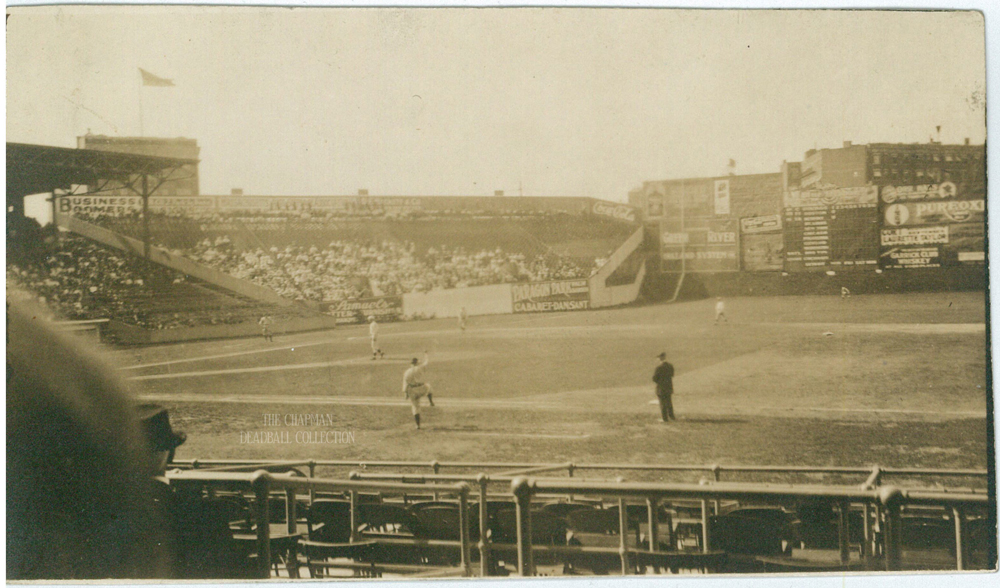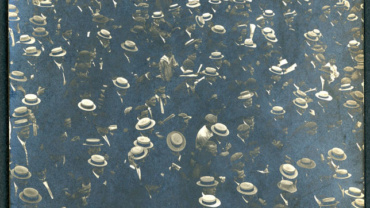This historically significant image is the earliest known original photo of Babe Ruth, the most celebrated baseball player ever, in the Majors. The image was likely snapped by a fan from the first base stands.
Ruth is on the mound in his second major league game on July 16, 1914. He is poised to deliver a pitch to the Detroit Tiger batter. Fenway Park had opened two years before in 1912. Note the slanted field at the left field wall, this was Duffy’s Cliff so named after the Red Sox left fielder Duffy Lewis.
The Society for American Baseball Research, SABR, published an article confirming Ruth’s identity. The article is in the June 2017 newsletter from SABR’s Pictorial History Committee found here: SABR June 2017 newsletter>>
Forbes and Beckett Vintage Collector have each also published articles about this postcard and noted its particular significance. The postcard has also been authenticated as Ruth on the mound in his second ML game by Beckett Authentication Services.
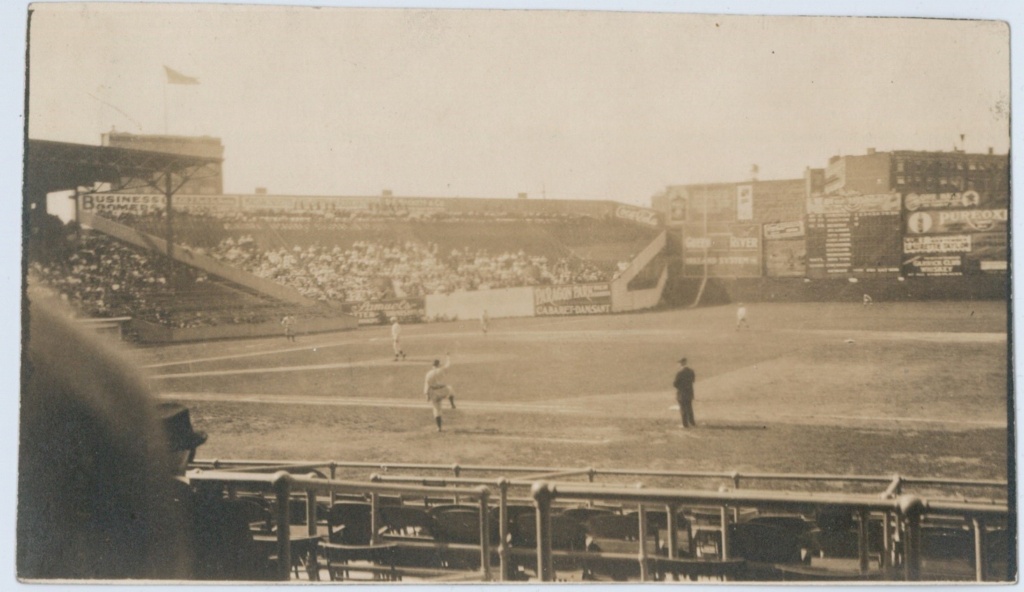

This RPPC is of Fenway Park in 1914. It has been trimmed to approximately 3 x 5 inches and was once pasted in an album as shown by the four pieces of black paper affixed to the back. Almost all of the photographic image is present as indicated by the dark edges on each side. On the top right back it is written in faded pencil “July 1914” and “Red Sox Stadium Boston” (Fenway as we know it). The particular style of “CYKO” stamp box seen on it was not used past 1915.
Here are known shots of the 1914 World Series at Fenway (Braves v. A’s) one version of which is labeled as such.
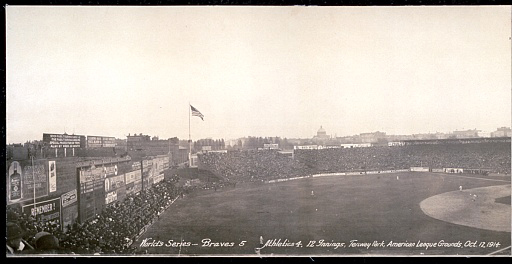

Most of the ads, and all of the ad sizes, on the original Green Monster are the same as on the postcard. The ads did occasionally change during the year, particularly for the World Series. The most notable change from our postcard to the World Series photo is the exchange of the “Remember! Budweiser” ad for the “Green River” ad in the corner, also note how much cleaner and fresher the Budweiser ad appears as compared to the other ads, which would be expected if it had been added later in the year or for the World Series. The scoreboard also shows “Boston” on top and “Philadelphia” on the bottom (at the time the custom was to show the hometown Red Sox, or Braves in this case, on top). Other known 1914 Fenway photos have the same billboards. Our postcard shows Fenway Park in 1914.
Which teams are playing? Examination of our postcard, in hand and under magnification, shows five games listed (all four AL games and the Boston NL game):
Boston v. Detroit (Boston listed on top as was the tradition, Detroit is shortest name on photos), St. Louis v. New York, Chicago v. Philadelphia, Cleveland v. Washington and Boston NL v. Cincinnati.
The full scoreboard from our postcard is enlarged below. It is critical to the confirmation of the teams, players and date for our postcard. For comparison’s sake, a known 1912 photo is included to show what the team names and the digits looked like on Fenway’s scoreboard.

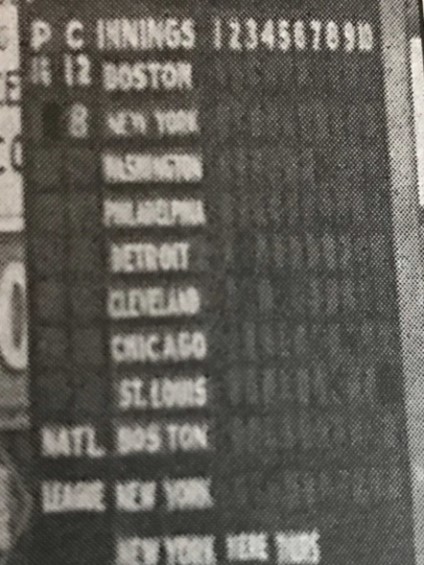
With the 1912 photo to confirm the static format (the top line, “NAT’L LEAGUE” and “HERE”, the entire contents of the scoreboard appear to read as follows:
P C INNINGS 1 2 3 4 5 6 7 8 9 10
171 11 BOSTON 0
16 11 DETROIT 0
ST. LOUIS
NEW YORK
CHICAGO
PHILADELPHIA
CLEVELAND
WASHINGTON
NAT’L BOSTON
LEAGUE CINCINNATI
DETROIT HERE FRI SAT MON
The only dates all of these games align with these pairings for 1914, and for any year from the opening of Fenway in 1912 to at least 1919, are Saturday May 16, Thursday July 16 (Boston NL v. Cincinnati rained out after four innings, 6-17-14 Boston Globe), Friday July 17 (Cleveland v. Washington and St. Louis v. New York were both rained out) and Saturday July 18. The only game in progress on our postcard is our game, Boston v. Detroit, which appears to be in the top of the second inning of a scoreless game based on the two numerals below inning “1” on the scoreboard. The uniforms depicted on the postcard are consistent with the 1914 uniforms of the Red Sox (home whites) and Tigers (road darks). Boston is in the field and the Tigers are at bat.
The details on the scoreboard show it is the Thursday July 16th game. The key factor is the bottom scoreboard line that shows Detroit is “HERE” (note it is in shorter type than the other text on both the 1912 and 1914 photos) “FRI” “SAT” (the most distinct) and “MON” which coincide with the dates in July when Detroit was in town for a four game series: Thursday the 16th, Friday the 17th, Saturday the 18th and Monday the 20th. No other day/dates match up other than these and this is the only time in 1914 that Saturday is the next to last game in the series as shown on the scoreboard. It is evident by this scoreboard plug for the three future games of the series that our postcard depicts the first game of the Detroit/Boston series on Thursday the 16th.




The scoreboard plug for future games at Fenway was updated daily. Here is a photo and crop of the scoreboard from the famous Johnson/Wood duel on Friday September 6, 1912 as well as the respective scorecards from the game that illustrate this point.
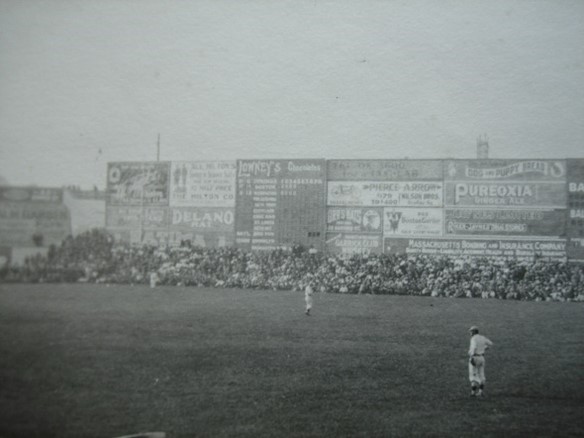
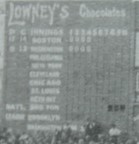
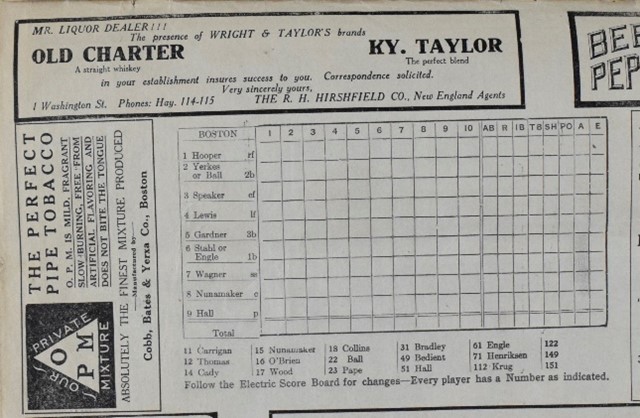
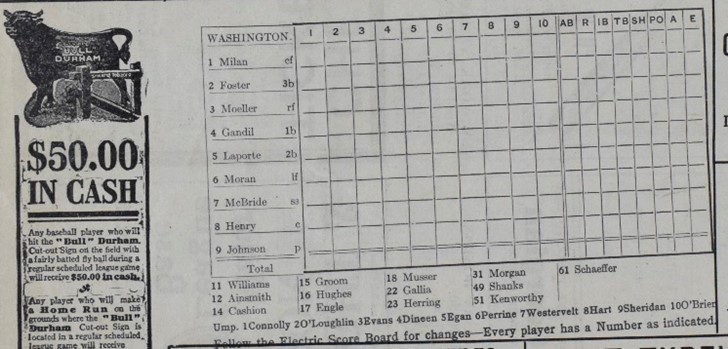
The batteries on the scoreboard align with the scorecards and the “Here” with the “S” from “SAT” is visible to the left of the standing fans with no further games shown to the right of the fans. The Washington/Boston series was Wednesday September 4th through Saturday September 7th with the Johnson/Wood duel occurring on Friday September 6th. The prior games of the series and the Friday then occurring Johnson/Wood game are not shown on the future game plug line, only the final game of the series on Saturday is listed. The future game plug rotated daily. This is consistent with the Thursday game for our postcard with the three future games of the series shown as “FRI” “SAT” and “SUN”.
Also, Fenway Park had an approximate capacity of 27,000 when built in 1912. The Detroit Free Press lists the attendance for our four games in question as Saturday May 16 (14,000), Thursday July 16 (8,936), Friday July 17 (6,655) and Saturday July 18 (17,926). The paucity of the crowd in the postcard suggests that one of the weekday/workday games with lighter attendance figures, such as July 16th, is the game depicted (Notice all the empty premium seats in front of our photographer and those down the line and also remember the 1st base line seating at Fenway is cavernous as compared to the 3rd base line and there is also the RF/CF bleachers). The Boston Globe reported it was 88 degrees with up to 97% humidity on July 16th. Our postcard annotator notes our game occurred in July and the predominance of white shirts in the crowd also seems to suggest a sultry July game rather than a mid-May game in Boston.
Below are the program’s team scorebook pages for the July 1914 Boston v. Detroit series (they were issued for each series). Based on the Rehg and High penciled in substitutions in the lineup this copy was the used during the Saturday July 18th game. The program reflects the following player numbers for the “Electric SCORE BOARD” (There were no uniform numbers in 1914). The scoreboard was actually manual, the “electric” reference on the scorecards comes from the fact the press box keyboard operator could send information to the scoreboard operators electronically.
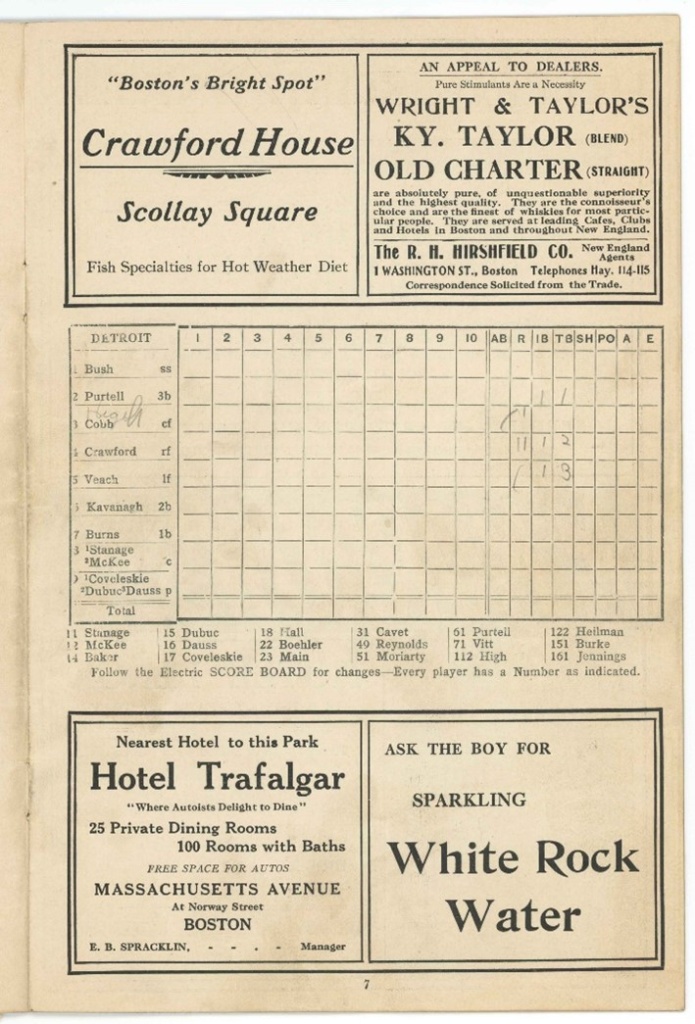

Ray Collins, a lefthander, started on Saturday May 16th and on Friday July 17th . both times opposed by Covaleski. Babe Ruth, a lefthander, in his second ML game started on Thursday July 16th against Dauss and lasted just three innings. Ernie Shore, a righthander, started on Saturday the 18th against Dubec.
Catchers Stanage and Carrigan were both “11” and started all three games in July.
Ruth “171” and Dauss “16” started Thursday July 16th.
Collins “16” and Covaleski “17” started Saturday May 16th and Friday July 17th.
Shore “223” and Dubuc “15” started Saturday July 18th.
The battery section of the scoreboard, according to the program should look like this for the four games:
July16th P C May 16th and July 17th P C July 18th P C
171 11 16 11 223 11
16 11 17 11 15 11
Below are enlargements of the scoreboard from our postcard.
“P” and “C” combinations with “11s” under the “C”

“P” super enlargements showing pitcher numbers 1912 World Series scoreboard

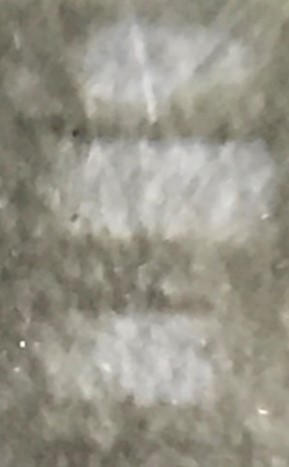
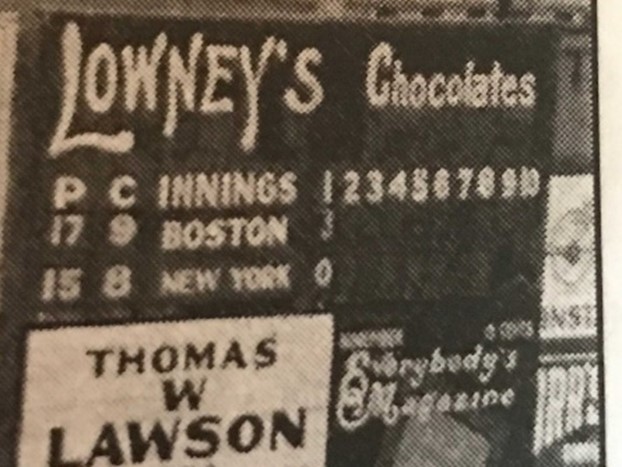
The postcard “P” detail is blurry, but it is evident that Boston’s pitcher number contains three digits while Detroit’s contains two digits. The picture on the right above shows what the digits looked like on the scoreboard. Note the curvature of the “6” the slant of the “7”. In the extreme enlargement of our postcard it appears “171” is decipherable on top under the “P”. The Detroit pitcher’s digits appear to be a “16” for Dauss; there is no way it would be a “17” for Covaleski and extremely doubtful for a “15” for Dubuc as it appears the bottom left of the second digit is enclosed and top of the digit curves like the “6” shown for the sixth inning. “171” vs. “16” would be Ruth v. Dauss on the 16th.
Also depicted on the postcard are left fielder Duffy Lewis (the inclined hill ramping up to the Green Monster was nicknamed Duffy’s Cliff), third baseman Larry Gardner and shortstop Everrett Scott. The Boston Globe game account mentions Veach made the last out of the first inning and that the Tigers went in order in the second inning; thus, the batter who is not visible, must be Kavanaugh, Burns or Stannage.
The Detroit first base coach appears to be executing signals with his arm and leg extended in a pose made famous by Hughie Jennings, the Tigers manager. It may be Jennings himself, or it may be Jimmy Burke as the July 17th edition of the Boston Globe reported that Jennings did not man the lines the day before on the 16th and had Burke handle the signal calling instead. Burke was of similar physical stature to Jennings. Whichever man, the signal caller would use the same team signals and would tend to station himself on the first base line when the opposition was pitching a lefthander, the better to observe and potentially rattle the pitcher (There is a famous story about Jennings and Rube Waddell and a toy).
The pitcher below is none other than lefthander Babe Ruth in his 2nd ML game

As unlikely as the discovery of this Ruth postcard is, the story gets even better. In my research outreach to a few hobbyists, a fellow collector discovered these two photos from the same game in his collection. While unidentifiable on their own, considered in conjunction with the postcard they serve to independently corroborate the game date and Ruth depicted on the postcard.
The images are 2 ½ x 4 ¼ and were likely taken on a Kodak 1A or Brownie 2A camera based on the image size. It is highly likely they were taken by the same photographer as the postcard. They are from similar vantage points as the postcard and all three are likely taken by a camera toting fan. The black paper that the photos are affixed to is the same as seen on the back of the postcard.
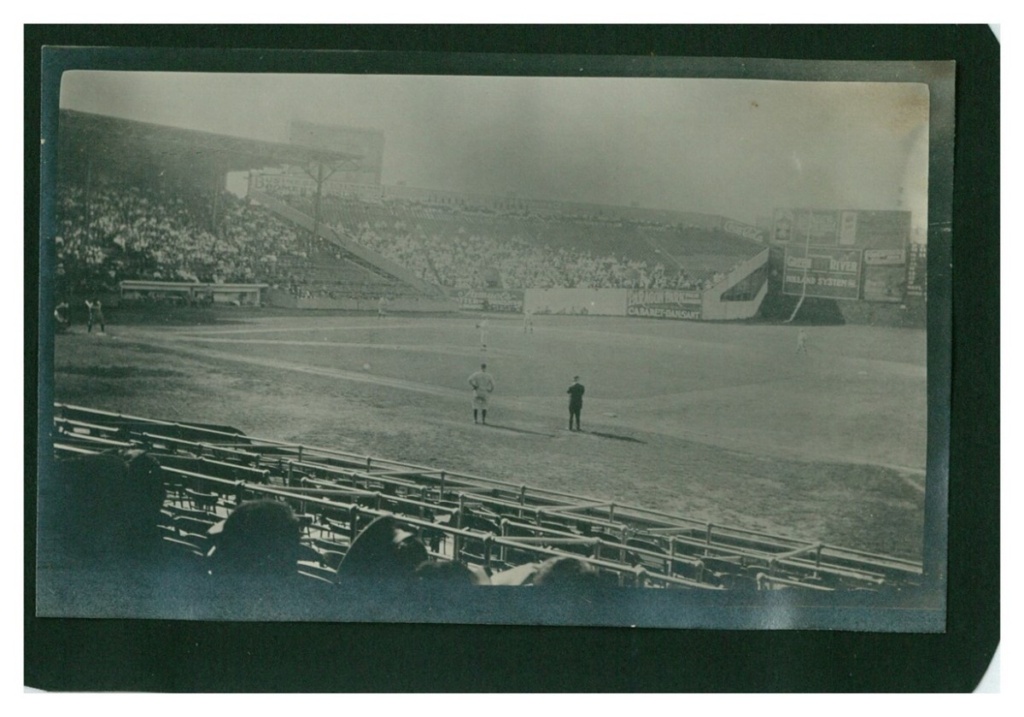
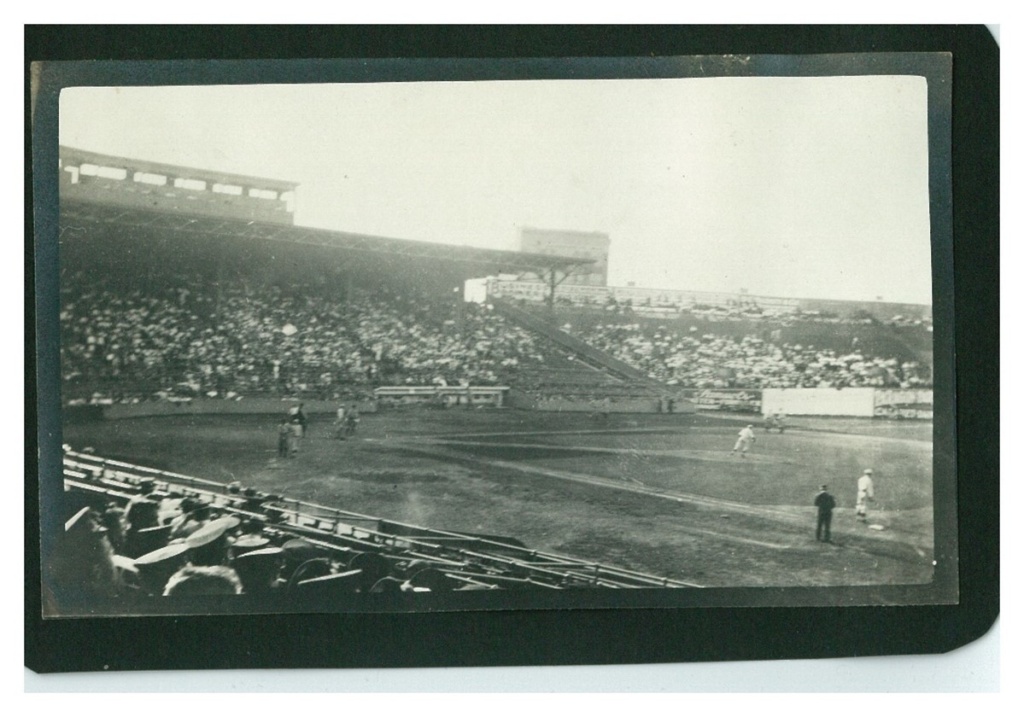
The photos are obviously Fenway from the same year given the billboards. The next thing we notice is that the crowd pattern is almost identical, even down to the individual fan level, note the lone fan in white at the far right edge of the main covered grandstand. The odds of this exact pattern repeating at any other game are extremely remote.



Also notice the shadow patterns on the Green River leftfield corner sign in the full images, in the crops above in front of the main grandstand and in the creep of the press box shadow which has reached halfway between the plate and mound in the last photo. The sun is behind the third base side at Fenway and based on the shadows the postcard is obviously earlier in time than the first photo and considerably earlier in time than the second photo.
Below are enlargements of the two pitchers depicted in the black and white photos.

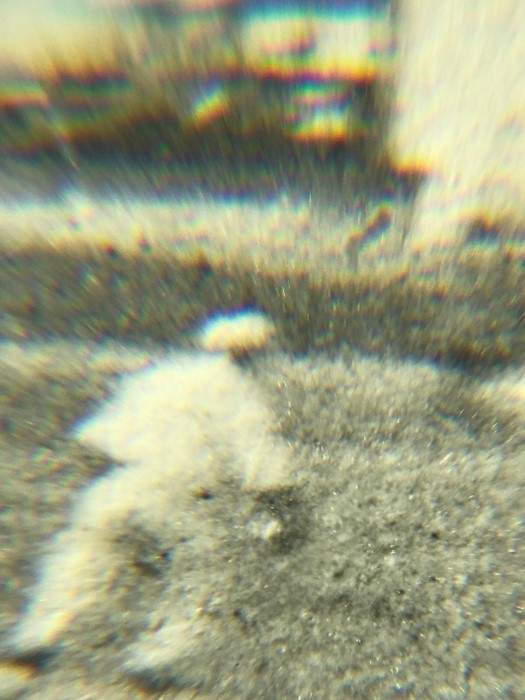
The one on the left, with the pitcher poised on the mound is likely Rankin Johnson, who pitched from the 4th inning through the 7th on the 16th. We know that the shadows have advanced some from the time Ruth was on the mound in the 2nd. We can also see the entire glove with no evidence of the pitcher’s hand or the baseball and as the batter is in his batting stance we know the pitcher is poised and ready to deliver the pitch. It must be the righthander Johnson in the first photo.
The one on the right, with the pitcher stepping off the mound is likely Fritz Coumbe the lefthander who worked the 8th and 9th innings on the 16th. The shadows have substantially lengthened and a glove is evident on the right hand of the pitcher.
The other critical factor, in addition to the crowd pattern, that establishes that this is indeed our game between Detroit and Boston on July 16, 1914 is the left edge of the scoreboard that is just evident at the far right edge of the first photo and which lists the out of town pitcher numbers in the first column. We can use 1914 game programs to decipher which pitchers were on the mound in the out of town contests played that day and listed on the scoreboard photo.
Below is “Electric Score Board Information” for out of town for pitchers taken from the game program for our July Detroit at Boston series.

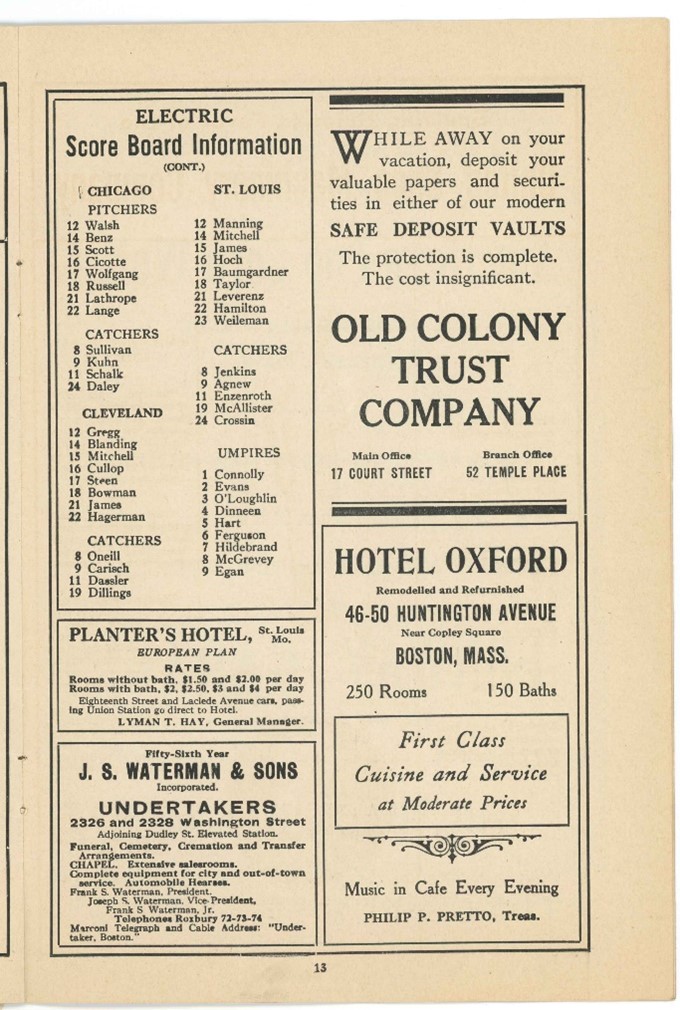
The fans at Fenway would use the Boston and visiting scorecards for the game they were attending and would refer to the “Electric Score Board Information” for the battery information for the out of town AL games.
It is important to note that the numbers vary between our Detroit at Boston game day scorecards and the out of town list, for example Hagerman is “18” on the game day scorecard but “22” on the out of town list. This allowed the Red Sox to update pertinent transaction information for the games at Fenway so the fans could score along. For example although Ruth is not listed for his first game mere days after he was acquired, by his second start, our game, he is listed, as “171”, along with Shore and Egan who were acquired with him, in the far right column of our Detroit at Boston series scorecard.
Armed with this information, below are listed the pitchers who appeared in the out of town games based on boxscores for July 16th with their “number” based on the out of town pitcher list from the program. Remember there is a lag for updated information from out of town games as no numbers were listed for them yet when Ruth was on the mound in the 2nd.
BOSTON “171” Ruth for 1-4 innings, “23” Johnson for 4-7 and “31” Coumbe 8-9th.
DETROIT “16” Dauss – complete game
ST. LOUIS “17” Baumgardner 1-4, James “15” for 4-7 and “23” Weilman for 8-9th.
NEW YORK “31” Pieh for 1-4 and “61” Brown for 5-9th.
CHICAGO “18” Russell for 1-3 and Faber for 4-8th.
PHILADELPHIA “12” Bender for 1-4, “18” Bush for 4-6 and Bressler for 7-9th.
CLEVELAND “22” Hagerman – complete game
WASHINGTON “18” Shaw for 1-3 and “16” Boehling for 4-9th.
The enlargements of the scoreboard from the photo with the pitcher poised on the mound are below. Based on the shadows and pitcher enlargement the scoreboard shot as depicted was likely taken somewhere from the 4th to 7th inning, with the 4th or 5th inning most likely when Rankin Johnson was on the mound as discussed above.
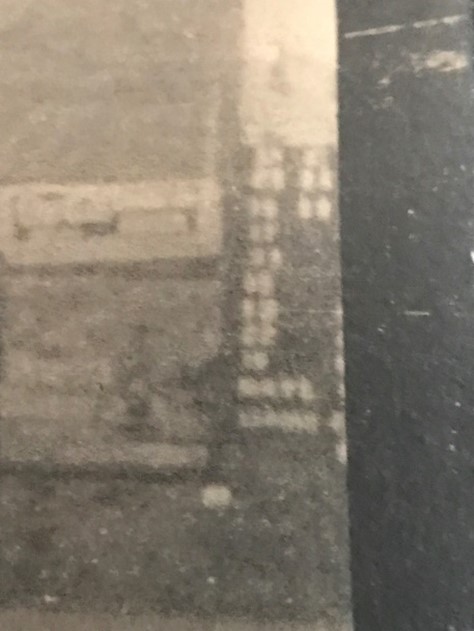
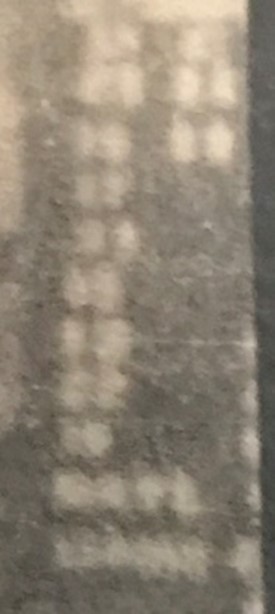
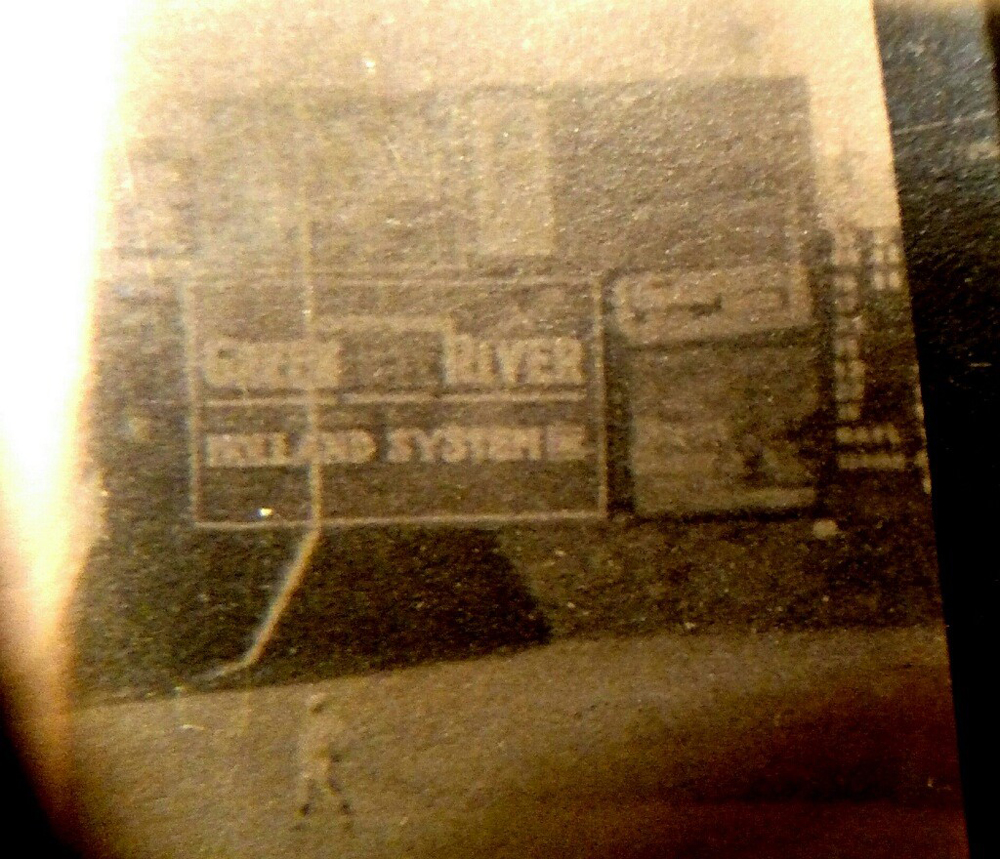
The clearest number is the “22” for Hagerman in the Cleveland slot two numbers above the “NAT’L”. Hagerman pitched the entire game for Cleveland on the 16th. The “12” for Bender from Philadelphia is also evident just above that. The “16” for Dauss for Detroit on the photo scoreboard though blurry looks like the same shape for him of the “16” on our postcard. It is interesting to note the “teen” digits appear to somewhat smaller than those for other numbers. The smaller “17” for Baumgardner of St. Louis is just under Dauss’s “16” and the “18” for Russell of Chicago and Shaw of Washington are also smaller. The “31 for Pieh of New York is slightly offset below the “17”.
The Boston pitcher is definitely two digits, and thus not Ruth’s “171”, and is very likely to be “23” for Johnson as the apparent “2” first digit of the number looks like the “2” in Hagerman’s “22”. Also note, that to the right of “League” the beginning of “Cincinnati” protrudes to the left of the “Boston” above, just as it does on the postcard, to accommodate the longer city name.
Taken together this information from the photos independently corroborate the postcard identification and establish with certainty that it is indeed Ruth on mound on the postcard. It was a truly fortuitous series of discoveries that allows us to enjoy these photos of Babe Ruth’s second game and the postcard depicting the earliest yet known major league image of him. We now know what it was like to watch Babe Ruth in his second career start.


